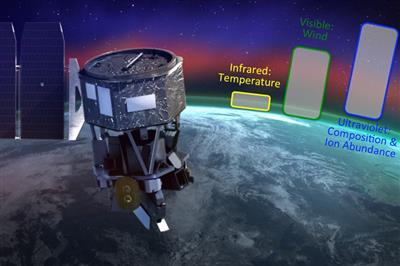Section: New Results
Solving inverse problems related to FUV image processing for ICON mission
Participant : Josiane Zerubia [contact] .
This work has been conducted in collaboration with Prof. Farzad Kamalabadi, Dr. Jianqi Qin and Dr. Mark Butala from Coordinated Science Laboratory (CSL, http://www.csl.illinois.edu/) at University of Illinois at Urbana Champaign (UIUC, http://illinois.edu/)
ICON (Ionospheric Connection Explorer) is a satellite which is part of the NASA Explorer missions (see http://icon.ssl.berkeley.edu/) and is planned to be launched in 2017 (see Fig. 4). The main goal of ICON is to study the area where terrestrial weather meets space weather in order to understand the behavior of our planet's upper atmosphere, including what causes disruptions in this region, such as those that can significantly affect radio transmissions.
There will be 4 instruments on board. One of them is the FUV: Far UltraViolet spectrographic imager. Prof Kamalabadi is responsible to process the FUV data from this instrument. During Josiane Zerubia's stay at CSL, UIUC, she worked with Prof. Farzad Kamalabadi team on defining a proper energy function using Bayesian theory (i.e. defining a data term + various priors for regularizing the solution) in order to be able to take into account the geometry of the information and also to deal with optical transmission function. This inverse problem is highly non linear. We will continue in the future to work on the problem of the error estimation (or bound derivation) as far as the estimation of distribution parameters is concerned.


